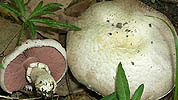Agaricus bitorquis
Older Names
Agaricus rodmanii
 Key to Gilled Mushrooms Key
Key to Gilled Mushrooms KeyThis is a key to gilled mushrooms, that is, mushrooms having a definite cap with a fertile surface consisting of gills. The fruiting body usually also has a stem, although that may be lateral or absent (usually, then, the mushroom is growing from wood). You can use this key to identify mushrooms that you find.
 Agaricales Order
Agaricales OrderFruiting body containing fibers (usually in the stalk)
 Agaricus Genus
Agaricus GenusGills free
Spore print chocolate brown
Annulus almost always present, usually membranous
The gills are usually pink or silvery-grey at first, but are colored chocolate brown at maturity from the developing spores
The cap and stalk are usually some sort of white or greyish brown, but may have fibrils or scales that are darker (like the portobello)
Growing on the ground, wood chips, or other organic debris
Bitorques SectionNo color-changing reactions.
Often fruiting in poor, dry, pebbly soil.
Flesh often very hard (like a carrot).
Annulus is caligate and single-layered
Here are the characters that distinguish this species from the others in its group. For its more general characters, see higher up on the page.
If there's just a few words or a microscopic feature here, a more thorough description can be found above.

Diagnosis
- Cap up to 6" across; glabrous; margin inrolled when young, often extending beyond the gills in maturity
-
Ring often pulling away from the stalk at its top edge and its bottom edge, often flaring
-
Usually barely breaking the surface of the ground
Microscropic Characters
Comments
The ring that comes off the stalk at both its top and its bottom gives the species its name.
The semi-underground fruiting is an important feature. In the lawns and muddy stretches of ground where I often find them, the ones that have clearly broken through the surface are the older ones, and may be buggy or moldy; but one can search around them for less precocious individuals that look (at the moment) like almost completely buried white stones






 Key to Gilled Mushrooms Key
Key to Gilled Mushrooms Key Agaricales Order
Agaricales Order Agaricus Genus
Agaricus Genus





